Trust_Uploader
Active Member

RAM Concept CONNECT Edition V8 Update 4 | 2.6 Gb
The Structural Products development team is pleased to announce the availability of RAM Concept CONNECT Edition Update 4 (08.04.00.122) is structural software for the design of post-tensioned and reinforced concrete floors including slabs, mats, and rafts.
RAM Concept CE Update 4 (08.04.00.122) Release Notes - Date:November 2022
Early Access Program - iTwin Synchronization to Cloud Workflow
The Early Access Program (EAP) for the iTwin Synchronize to Cloud Workflow continues with this version. A practical application of this technology is the ability for RAM Concept users push PT tendon profiles to a 3D analytical iTwin and review those profiles in elevation/cross section views across the floor (see image below). RAM Concept users can access the capabilities of this workflow at no additional charge by participating in the program. After the EAP concludes, a separate license will be required to access the cloud synchronization features. The local iTwin Synchronize to File Workflow is and will continue to be included with the RAM Concept license.
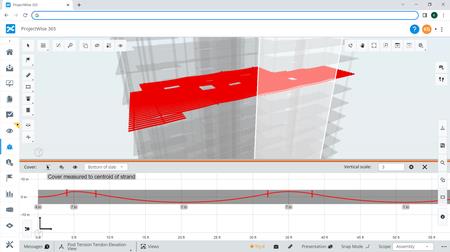
RAM Concept CONNECT Edition V8 Update4 includes thenew features discussed below.
Deflection Checks
Maximum and minimum deflection limits can now be defined and checked during the design calculations. The deflection limits can be based on absolute deflection or span deflection (L/D) and are compared to calculated deflections, which can be total deflections or differential deflections between any loading, load combination, or load history step. Deflection limits can be assigned to span segments or to new deflection check line objects, which can be modeled at any location on the floor. The results and design status of each deflection check are summarized on a new Deflection Check Layer.

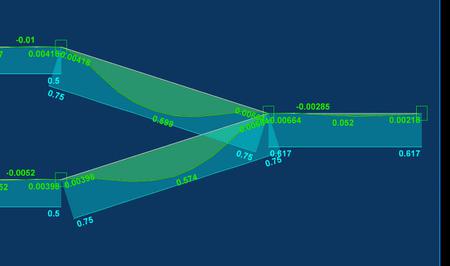
RAM ConceptCONNECT Edition V8 Update4includes theenhancementsdiscussed below.
PT Design Optimization ChangesTendon Parameter Object Changes
The following enhancements have been made to tendon parameter objects to improve the PT Design Optimization workflow:
The Selection Filter can now be used to filter profile polylines by Support and/or Span location type. This allows users to easily select only support polylines or only span profiles polylines.
Optimizable objects and non-optimizable objects are now displayed with a different color. This allows users to easily distinguish objects that are defined as optimizable from those that are not.
Organizations with active subscriptions of any of the following can continue to use the PT Design Optimization feature at no additional charge:
- Enterprise (E365 or ELS)
- SELECT Structural WorkSuite
- SELECT RAM Concept Post Tension
- Virtuoso Structural WorkSuite
- Virtuoso RAM Concept Post Tension
Organizations that do not own a qualifying subscription are automatically prevented from starting or resuming optimizations.
A maximum monthly compute time restriction has been set for each organization to protect Bentley Systems from incurring excessive cloud costs. When the maximum compute time threshold is reached, all users in the organization are prevented from starting or resuming optimizations until the start of the next calendar month.
Bentley Systems does not invoice organizations for RAM Concept PT Design Optimization usage. Access to the PT Design Optimization feature is pre-paid as part of a qualifying subscription. If your organization has reached its monthly compute time threshold or does not own a qualifying subscription, you will be prevented from starting or resuming optimizations and will not be invoiced for over usage at a later date.
The following changes have been made to improve the PT Design Optimization workflow:
- Deflection checks can now be considered as one of the design constraints for valid solutions.
- Optimizations can now be started without assigning a CONNECTED Project to the model file.
- References to ACUs (Analytical Compute Unit) have been removed from the user interface.
- An option to stop optimizations when a specified number of iterations complete and a valid solution has not been found has been added as a stopping criteria.
- The Trial Diversity Slider in the Start Optimization dialog has been moved to a separate Advanced Settings menu.
Tendon Parameter Object Changes
The following enhancements have been made to tendon parameter objects to improve the PT Design Optimization workflow:
- The Selection Filter can now be used to filter profile polylines by Support and/or Span location type. This allows users to easily select only support polylines or only span profiles polylines.
- Optimizable objects and non-optimizable objects are now displayed with a different color. This allows users to easily distinguish objects that are defined as optimizable from those that are not.
Split Span Segment Tool
A split span segment tool is now available for splitting previously modeled design span segments where they intersect a defined splitting line. This can be useful, for example, when design properties need to vary along a design span.
iTwin Synchronization Improvements
Individual RAM Concept models can now be synchronized into a single local or digital iTwin repository. This allows users to create full 3D iTwin repositories from floors modeled in separate RAM Concept files.
A tutorial for this workflow, including sample files, is also available. See "Other Changes" section below for details.
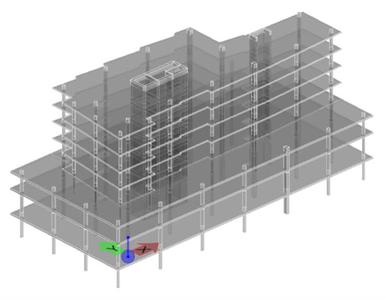
Wall Element Properties
Wall length and area are now tabulated for each wall element group. These properties can also be extracted using the scripting API. Wall reactions per unit wall length can be calculated by associating Wall Group Names with Wall Group Reactions and the new Wall Element Total Length property.
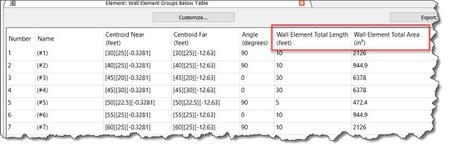
Unselect Objects Using ESC Key
Selected objects can now be unselected by clicking on the ESC key. When multiple objects are selected, ESC will clear all selections.
RAM Concept CONNECT Edition V8 Update4 also includes thechanges discussed below.
AS 3600-2018 Strut Angle Selections for Shear/Torsion Design
New options have been added to control the diagonal compression strut angle determined for the AS 3600-2018 shear/torsion model.
In previous versions, an initial flexural/axial design was performed to determine the longitudinal reinforcement strain,which was then used to calculate the strut angle. For slabs, the design was performed to limit to the maximum value that would prevent the need for transverse reinforcement. For beams, was designed to the maximum value that would satisfy strength using only minimum transverse reinforcement and was never designed less than 0.001.
The new strut angle determination options include:
- Automatically Calculate - This option uses the same assumptions used in previous versions that are described above.
- Minimize Longitudinal Reinforcement - This option uses the maximum strut angle (50 degrees). This will minimize the longitudinal reinforcement and may increase transverse shear reinforcement requirements.
- Minimize Transverse Reinforcement - This option uses a strut angle equal to 30 degrees. This angle coincides with a small, positive longitudinal reinforcement strain that tends to minimize transverse requirement requirements and may increase longitudinal reinforcement requirements.
- Specified Angle - This option allows the user to specify a strut angle. During design, longitudinal reinforcement is added as needed to ensure that the specified angle can be utilized.
The Minimize Longitudinal Reinforcement option is the default for new files. The Automatically Calculate option will be selected in files that were saved in a previous version and opened in this version.
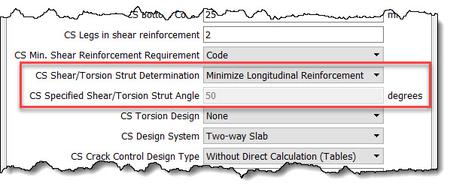
Calc Partial Dialog Changes
In the Calc Partial dialog, the Extent of Calculation options have been changed and now include an option to include the Load History Deflection calculations in the analysis. The "+ Load History D" will be useful when using deflection checks that reference load history layers.
This option will also allow for load history deflection calculations to be run to completion without interrupting errors or warning messages. This can be done by using the "Don't interrupt calcs for warnings" option when the "+ Load History D" option is selected.
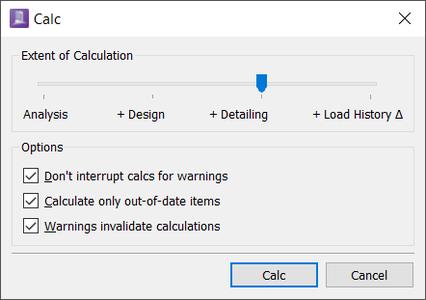
Enveloped Results for Hyperstatic Loadings
RAM Concept calculates the effects of the hyperstatic loading (Fh) by subtracting the effects of the physical tendon force (Fp) contained in the section from the effects of the balance loading (Fb):
Since hyperstatic effects can only be rigorously calculated on design cross sections, they have less meaning in slab contour Descriptions. An assumption is required to calculate the hyperstatic effect for such analysis results.
In previous versions, enveloped results for the hyperstatic loading were calculated assuming Fh = Fb. This conflicted with the standard results, which were calculated assuming Fh = 0.
Now all hyperstatic loading effects (standard, max, and min contexts) are calculated using the Fh = 0 assumption.
Warnings for Duplicate Supports
A warning is now displayed during mesh generation when one or more area springs, line springs, or line supports are modeled at the same exact location.
Assign Project Dialog for New Files
The Assign Project dialog no longer opens when new files are created. CONNECTED projects can still be associated with RAM Concept using the options in the Bentley Cloud Services menu.
Import DWG Files
DWG files can now be imported while the drawing is opened. Previously, an error was displayed while attempting to import the DWG file if it was open in another application or on another machine. The error stopped the import process.
Location and Links to RAM Concept Tutorial Files
The RAM Concept tutorial files are now saved in the following location:
C:\ProgramData\Bentley\Engineering\RAM Concept
Sample files and Getting Started Guides are now available for PT Design Optimization and the iTwin Synchronization workflows outlined in the Enhancement section above.
The Help menu now includes links to easily access the sample models and tutorial documents (see image below). When choosing these options, a File Explorer window will open to the directory where the respective files are saved.
Resolved Issues
RAM Concept CONNECT Edition V8 Update4 includes fixes for theissues discussed below.
ACI 318 Span Detailing Requirements
In the final design pass, the beta1 factor may have been calculated incorrectly based on the provided shear reinforcement. This caused Vu,min to be calculated incorrectly and caused the fitment spacing check to fail. When this issue occurred, the shear design was correct, but a failure was incorrectly reported.
Exception Error when Importing DWG Files
In rare cases, an exception error prevented certain DWG files from being imported into RAM Concept.
Errors when Opening and Printing Results Tables
In v08.03.00 and v08.03.01, some default reaction tables were setup to Description max or min context results when only standard results were available. This issue prevented users from opening the affected tables and caused an error to be displayed for the missing values when generating reports.
File Compatibility Warning
RAM Concept CONNECT Edition V8 Update4 can read all previous file formats but writes files in a format that cannot be read by previous versions.
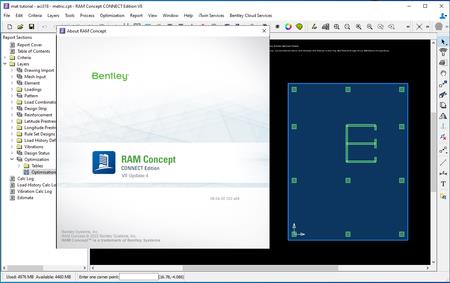
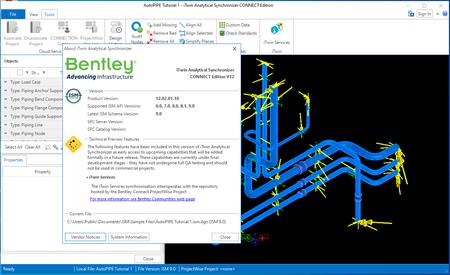
RAM Conceptis a software application for the structural analysis and design of conventionally reinforced and post-tensioned concrete floors, mats, and rafts. RAM Concept contains an advanced feature set that allows for the design of a wide variety of floor systems including post-tensioned, reinforced concrete and hybrid systems, elevated slabs and mat/raft foundations, one-way slabs, two-way slabs, beams, and joist systems. Historically, the vast majority of concrete floors have been analyzed by approximating a region of a slab as a frame (or design strip), and then analyzing the frame/strip using variations of conventional frame or moment distribution analysis techniques. There are two limitations to this approach. First, in irregular structures, the approximation of the real structure into a frame model could be grossly inaccurate and designing with the analysis results might not even satisfy equilibrium requirements in the real structure. The second limitation is that even in regular structures with regular loadings, the frame analysis approximates the slab/column interaction and provides no information regarding the distribution of forces across the design strip. RAM Concept enables the engineer to design post-tensioned and reinforced concrete slabs by using a finite element model of the entire slab. RAM Concept can predict the elastic behavior of a slab much more accurately than frame models. In addition, the finite element method guarantees that the analysis satisfies all equilibrium.
In this RAM Concept training video, we introduce you to the new post-tension optimization workflow.
Bentley Systems, Incorporatedis the global leader dedicated to providing architects, engineers, constructors, and owner-operators with comprehensive architecture and engineering software solutions for sustaining infrastructure. Founded in 1984, Bentley has nearly 3,000 colleagues in more than 45 countries, $500 million in annual revenues, and, since 2001, has invested more than $1 billion in research, development, and acquisitions.
Product:RAM Concept
Version:CONNECT Edition Update 4 (08.04.00.122)
Supported Architectures:x64
Website Home Page :
Languages Supported:english
System Requirements:Windows *
Size:2.6 Gb
Recommend Download Link Hight Speed | Please Say Thanks Keep Topic Live
Links are Interchangeable - No Password - Single Extraction
